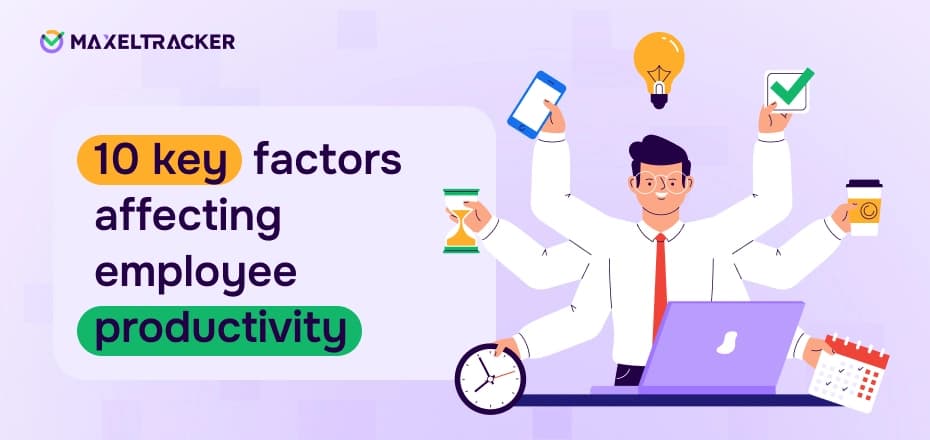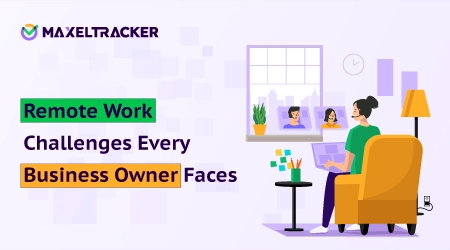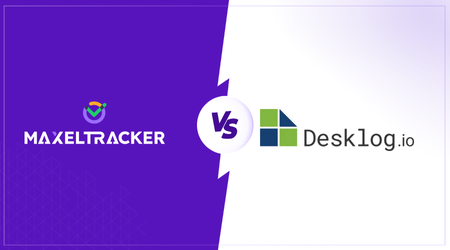

Employee productivity plays a critical role in shaping a company’s overall performance. It’s not just about how much work gets done—it’s about how effectively time, skills, and energy are directed toward achieving meaningful business goals. When productivity is high, teams meet deadlines, maintain quality, and contribute to steady growth. When it lags, even the most well-crafted strategies can fall short.
As a manager, your ability to identify and influence the factors behind productivity is vital. It’s not enough to set targets—you need to understand what helps your team stay focused, engaged, and efficient throughout the workday. From workplace culture to task clarity, small shifts can have a significant impact on how your employees perform.
In this guide, we’ll break down the 10 key factors that affect employee productivity and offer insights into how you can manage each one to create a more productive and motivated workforce.
Productivity isn’t just about getting more work done—it’s about working smarter. When employees complete tasks efficiently and maintain good quality, it benefits the whole company. You’ll see less wasted time, lower costs, better profits, and happier customers.
But the positive impact goes beyond the company. When you focus on removing obstacles to productivity, you create a better work environment. Employees feel more confident, appreciated, and motivated, which improves morale, reduces burnout, and encourages creativity and innovation.
Here’s how improved productivity leads to real, measurable improvements across the organization:
Productive employees complete more tasks in less time, without sacrificing quality. This allows your business to handle more projects or serve more customers without needing to hire additional staff. As a result, your operating costs stay lower, and your profits go up.
When your team consistently delivers great work, it becomes easier to set higher goals and track progress. Productivity improvements often go hand-in-hand with clearer processes and smarter tools, making it easier for managers to evaluate performance and support employee growth.
People feel more connected to their jobs when they know their efforts are making a difference. Productive employees often feel less frustrated and more motivated because they can actually see the results of their work. According to Gallup, engaged employees can help businesses become up to 21% more profitable.
A productive team responds to customer needs more quickly and accurately. Whether it’s solving a problem or delivering a product, faster service with fewer mistakes keeps customers satisfied—and loyal. When employees are efficient and happy, it shows in how they treat your clients.
When employees can finish their work during normal hours, they’re less stressed and less likely to feel overwhelmed. Meeting daily goals without constantly working overtime gives people a better work-life balance and leads to a more positive outlook on their jobs.
Employees who feel productive and appreciated are more likely to stay. That means fewer people leaving, less time spent hiring replacements, and a more stable team. Plus, when your company is known as a great place to work, it attracts more skilled candidates who want to be part of your team.
Several factors affect employee productivity in both positive and negative ways. While some factors are internal to the organization and others are external, these strategies will help you manage them all.
Technology plays a central role in how teams communicate, collaborate, and complete tasks. But productivity doesn’t come from simply having the right tools—it comes from using them well. Many companies invest in software without proper onboarding or without tracking how it actually impacts work. As a result, even the best tools can become distractions or bottlenecks when used incorrectly.
Start with proper training from day one. Make sure every employee knows how to use the tools relevant to their role. Review your tech stack regularly—especially within the first few months of adopting new tools—to assess whether they’re helping or hindering productivity. If a tool isn’t delivering value, dig deeper: Is it a lack of training, or is the tool simply not a good fit? This process can also reveal chances to cut unnecessary SaaS spending and explore better-performing alternatives.
Clear and consistent communication is essential for effective collaboration, idea-sharing, and building strong team relationships and tools that monitor apps and website usage can support this by providing insights into how teams interact and stay connected. When communication breaks down or becomes inconsistent, employees are left confused about expectations, priorities, or company direction, which slows down progress and weakens morale.
Provide your team with reliable communication tools, such as email, messaging apps, video conferencing, and project management platforms—but don’t stop there. Define when and how these tools should be used. Set clear guidelines to reduce noise, limit unnecessary meetings, and avoid information overload. Strong communication policies help employees stay focused, informed, and aligned without burning out.
Productivity thrives when employees know exactly what’s expected of them and how their work contributes to the bigger picture. Clear roles and well-defined goals give people a sense of purpose and direction. When expectations are vague, deadlines are missed, accountability drops, and motivation fades. Employees also perform better when their personal growth goals align with the company’s vision.
Set SMART goals—specific, measurable, achievable, relevant, and time-bound—at every level: individual, team, and department. Review progress regularly and keep goals visible across the organization. From day one (or during any role change), ensure HR clearly communicates each employee’s responsibilities and how their success will be measured.
Strong leadership plays a vital role in driving employee productivity. When leaders set the tone with clarity, consistency, and support, teams are more focused and motivated. Employees look to managers and executives not just for direction, but for guidance, trust, and accountability. On the other hand, poor leadership—marked by indecision, lack of support, or inconsistent communication—can demoralize even the most capable teams.
Invest in ongoing leadership training to ensure managers are equipped to lead effectively. Establish policies that help leaders build a positive, productive environment—one where expectations are clear, achievements are recognized, and feedback is timely. Give managers the tools and authority to support their teams and lead with confidence.
A positive work culture and engaged employees go hand in hand with higher productivity. When people feel valued, connected, and aligned with the company’s mission, their morale and productivity increase, making them more motivated, creative, and committed.. Teams that share strong relationships and a clear sense of purpose tend to perform better and stay longer.
Build a culture that supports growth, recognition, and open communication. Foster engagement through regular feedback, meaningful rewards, and opportunities for professional development. Encourage team bonding through shared goals and social interaction. Make sure your mission, values, and company objectives are clearly communicated, and take employee feedback seriously by acting on it.
Employee well-being—both mental and physical—has a direct impact on productivity. Burnout, stress, and poor health reduce focus and energy, while a supportive environment helps people perform at their best. When employees feel their health is valued, they’re more engaged, motivated, and loyal to the organization.
Provide comprehensive health benefits that cover mental health, vision, dental, and preventive care. Encourage regular breaks, time off, and a healthy work-life balance. Offer wellness programs like fitness memberships or guided mindfulness sessions. Train managers to support well-being in their teams and to respect boundaries that help prevent burnout.
Ongoing training is essential for keeping employees productive, confident, and prepared for growth. It not only sharpens skills for current roles but also prepares individuals for future responsibilities. When employees see that the organization is invested in their development, they’re more likely to stay committed and perform at a higher level.
Identify skill gaps and training needs using performance reviews or productivity data. Offer targeted training programs that build both technical and soft skills. Encourage continuous learning—whether through internal workshops, online courses, or external certifications. Support employees who want to grow, and recognize those who take initiative to learn.
Recognizing effort and rewarding results are powerful drivers of productivity. Employee appreciation boosts motivation, strengthens morale, and fosters a culture of celebration. Beyond personal motivation, recognition also strengthens team morale and creates a culture of support and celebration.
Develop transparent incentive programs that outline how employees can grow through promotions, raises, or bonuses, and clearly communicate these opportunities. Celebrate both individual and team achievements across the company. Apply recognition fairly and consistently, using performance data to back decisions. Don’t overlook personal milestones like work anniversaries or goal completions—these small moments help people feel seen and valued.
Effective time management is a hallmark of productive employees. When people are given realistic workloads and the autonomy to manage their day, they’re more likely to stay focused and meet deadlines. But poor planning, micromanagement, and an overload of meetings can disrupt even the best time managers and lead to frustration or burnout.
Track how time is spent on tasks and use that data to set realistic productivity goals. Distribute workloads evenly to prevent overburdening any one team or individual. Promote a culture of time awareness by encouraging experienced employees to share strategies that work for them. Use productivity tracking tools to identify peak employee performance hours and schedule meetings or collaborative work accordingly—so they support, rather than interrupt, employee focus.
A well-designed work environment, whether remote or in-office, plays a critical role in how focused and productive employees can be. Noise, interruptions, poor lighting, or uncomfortable setups can quickly drain energy and motivation, while a supportive space encourages better focus and performance.
Encourage employees to personalize their workspaces in ways that support concentration and comfort, from ergonomic furniture to good lighting. Equip remote team members with the tools and equipment they need to work efficiently from anywhere. Consider flexible work arrangements that allow employees to balance personal responsibilities, like adjusting work hours for childcare, without sacrificing productivity. The more control employees have over their environment, the more likely they are to thrive in it.
Creating a productive work environment for employees requires more than just good processes—it takes ongoing visibility, the right support, and a clear understanding of how your team works. From managing workloads to improving focus, every small improvement can make a big difference.
MaxelTracker, a Remote Employee Monitoring Software that helps organizations get real-time insights into how time is spent, making it easier to identify unproductive patterns, support employees, and drive better outcomes. With the right visibility, you can remove barriers to productivity and build a workplace where teams stay engaged, motivated, and on track to meet their goals.
👉 Sign up now at MaxelTracker.com and start transforming your team’s productivity today! 🚀
👉 Explore our pricing plans and features to find the perfect solution for your team’s productivity needs! 🚀
Related Blogs

15 Remote Work Challenges Every Business Owner Faces — And How to Solve Them
Remote work rings a familiar bell, and it offers flexibility and global reach as well. But for CEOs, HR heads, and other important position holders across countries like USA, UK, Canada, or UAE, it is often the bringer of stress.

Insightful Alternatives & Competitors
Looking for an alternative to Insightful that offers a more tailored approach to workforce productivity and employee monitoring? We’ve got you covered.

Desklog Alternatives & Competitors
MaxelTracker is an all-in-one workforce platform that tracks time, monitors activity, and delivers deep productivity insights, giving you more than just project and task logging.